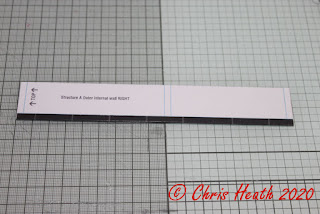In the previous post, I constructed the main box with the canal and wharf areas. It’s time now to start the buildings.
I’m starting with Structure “A”.
Firstly, cut out the back. Now it’s important at this stage to check the fit in your box file. Depending on how thick you’ve made the base, will determine how the structure will fit in the box. On the left hand side, there’s a light grey grid. If you offer up the back of the building to the side of the box file, standing it on the base, you can see where you will need mark the height and cut the back to fit.

Once you’ve done the back, cut out the front. You can now emulate the height you need on the front from the back.

Next cut out the right hand side walls.

Also cut out and make up the drain pipe. Once you have all of the elements, glue them all back to back. Apart from the short one. (I got ahead of myself and cut this one and the floors out prematurely).


Cut out the corner supports next.

Using the corner supports, glue the wall and drain pipe section in place. Take notice that the arrows go to the back. This is important. As there is a small notch for a narrow section of wall to go adjacent to the drain pipe.

Glue the floors in next. Making sure to keep everything square.

Now cut out and glue the left hand walls together and glue in place.

That small section gets glued on to the back next. Again adjusting to fit.

The front cover layer is next. Carefully cut out the windows. For some reason, I’ve replaced the door aperture on the base layer and taped it back in. Don’t ask me why, it does need to be cut out. Leave the door on the cover layer intact for now. It makes it easier to attach to the base layer.

Wrap all of the window sides next.

Next is to cover the raw edge with the window sills.



Once all of the sills are done, flip the wall face side down and cut out the door, using the base as a guide.

There’s a very smart brick header and door edge to fit next.

The windows are next. I’m using the very convenient Scaleglaze windows. I love These windows make my life so much easier. One sheet of Scaleglaze 5 is all you need.

Next are the doors.
There are three parts to the door. A base, a cover and a baton frame.

I always take time to colour any edges that might not be covered by a cover layer.



Fit the completed front to the walls.
Be careful on the next step and make sure you cut the corner “A” from corner “B”. This allows “A” to be glued onto the small flat area of the corner pieces, and the “B” to be glued over the top of “A”.


Corner stone cover next with the brackets for the drain pipes.


The roof next.
Start with the cutting out the gutter base layer and wrapping the cover layer.

Cut out the small recess to allow it to fit around the gable wall. Test fit and glue in place.


Cut out and glue the roof supports in place. Carefully to align the arrows to the back.

Cut out the roof base layer and the slate strips.

Start at the bottom and work your way to the top with the slate strips.

Trim of any excess. Then fit to the roof supports.

Glue on the ridge tiles.

Fit the left hand side cover layer. This will become apparent when structure C is built.

A water tower is next. It’s just a simple box design. With a socket on the bottom to fit into the main building.





Add the cover layer once the box is dry.

Cut out the roof and add its cover layer. And glue it in place.

This just now slips into the hole on the top of structure A. Do not glue this in place. It needs to be removed when the kit is packed away.

And that’s Structure A done.

And in place on the wharf.

Structure B will be next.
I’m enjoying this build. There are few new different building techniques with this kit. They make the build a lot easier.
Until Next Time...........
























